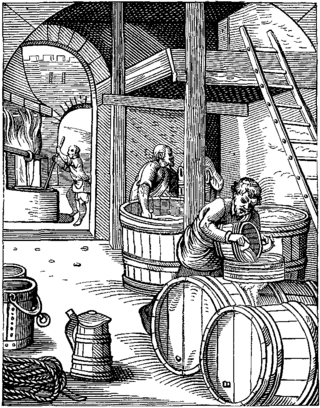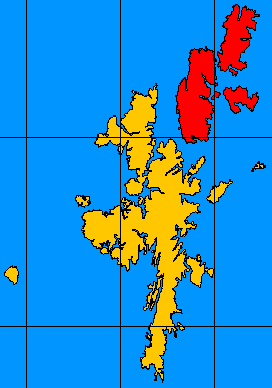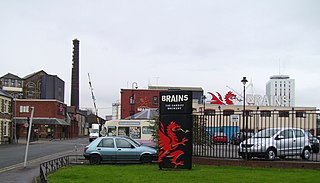
Beer is the oldest and most widely consumed type of alcoholic drink in the world, and the third most popular drink overall after potable water and tea. It is produced by the brewing and fermentation of starches, mainly derived from cereal grains—most commonly from malted barley, though wheat, maize (corn), rice, and oats are also used. During the brewing process, fermentation of the starch sugars in the wort produces ethanol and carbonation in the resulting beer. Most modern beer is brewed with hops, which add bitterness and other flavours and act as a natural preservative and stabilizing agent. Other flavouring agents such as gruit, herbs, or fruits may be included or used instead of hops. In commercial brewing, the natural carbonation effect is often removed during processing and replaced with forced carbonation.

Brewing is the production of beer by steeping a starch source in water and fermenting the resulting sweet liquid with yeast. It may be done in a brewery by a commercial brewer, at home by a homebrewer, or communally. Brewing has taken place since around the 6th millennium BC, and archaeological evidence suggests that emerging civilizations, including ancient Egypt and Mesopotamia, brewed beer. Since the nineteenth century the brewing industry has been part of most western economies.
Adnams is a regional brewery founded in 1872 in Southwold, Suffolk, England, by George and Ernest Adnams. It produces cask ale and bottled beers. Annual production is around 85,000 barrels.

Barley wine is a strong ale between 6–12% alcohol by volume.

Craft beer is a beer that has been made by craft breweries. They produce smaller amounts of beer, typically less than large breweries, and are often independently owned. Such breweries are generally perceived and marketed as having an emphasis on enthusiasm, new flavours, and varied brewing techniques.

Old ale is a form of strong ale. The term is commonly applied to dark, malty beers in England, generally above 5% ABV, and also to dark ales of any strength in Australia. It is sometimes associated with stock ale or, archaically, keeping ale, in which the beer is held at the brewery. In modern times, the line has blurred between Old Ale and Barley wine.
Unst is one of the North Isles of the Shetland Islands, Scotland. It is the northernmost of the inhabited British Isles and is the third-largest island in Shetland after Mainland and Yell. It has an area of 46 sq mi (120 km2).

The North Isles are the northern islands of the Shetland Islands, Scotland. The main islands in the group are Yell, Unst and Fetlar. Sometimes the islands in Yell Sound are included in this group.

Bass Brewery was founded in 1777 by William Bass in Burton-upon-Trent, Staffordshire, England. The main brand was Bass Pale Ale, once the highest-selling beer in the UK. By 1877, Bass had become the largest brewery in the world, with an annual output of one million barrels. Its pale ale was exported throughout the British Empire, and the company's iconic red triangle became the UK's first registered trade mark.

Fuller's Brewery in Chiswick in the west of London was a family-run business from its foundation in 1845 until 2019. In that year, the brewing division of Fuller, Smith & Turner PLC was sold to the Japanese international beverage giant Asahi.

Beer in Wales can be traced to the 6th century. Since the 2000s, there has been a growing microbrewery industry in Wales.

Beer is the most popular alcoholic drink in New Zealand, accounting for 63% of available alcohol for sale. At around 64.7 litres per person per annum, New Zealand is ranked 27th in global beer consumption per capita. The vast majority of beer produced in New Zealand is a type of lager, either pale or amber in colour, and typically 4–5% alcohol by volume.
This article is about the main brands of beer produced and served in Romania, also revolving around the history of this beverage on the territory of the Romanian lands, since at least the times of the Romanian Old Kingdom to contemporary times. The hereby article also focuses on the local breweries and craft beers.

Beer is one of the oldest drinks humans have produced. The first chemically confirmed barley beer dates back to the 5th millennium BC in modern-day Iran, and was recorded in the written history of ancient Egypt and Mesopotamia and spread throughout the world.

The Swannay Brewery is situated in Orkney, Scotland. It was founded as Highland Brewing Company in 2005 by Rob Hill, formerly of the Orkney Brewery and Moorhouse's Brewery. It is situated in the old Creamery at Swannay Farms, Orkney Mainland.

Bere, pronounced "bear," is a six-row barley currently cultivated mainly on 5-15 hectares of land in Orkney, Scotland. It is also grown in Shetland, Caithness and on a very small scale by a few crofters on some of the Western Isles, i.e. North Uist, Benbecula, South Uist, Islay and Barra. It is probably Britain's oldest cereal in continuous commercial cultivation.

Beer is often made from barley malt, water, hops and yeast and so is often suitable for vegans and vegetarians. Some beer brewers add finings to clarify the beer when racking into a barrel. Finings can include plant-derived products, like Irish moss, or animal-derived products, like isinglass and gelatin.

Beer in Scotland is mostly produced by breweries in the central Lowlands, which also contain the main centres of population. Edinburgh and Alloa in particular became noted for the export of beer around the world in the 19th century.

Australian International Beer Awards (AIBA) is an annual brewing competition that commenced in 1992.
















